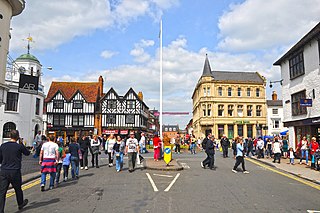
Stratford-upon-Avon, commonly known as just Stratford, is a market town and civil parish in the Stratford-on-Avon district, in the county of Warwickshire, in the West Midlands region of England. It is situated on the River Avon, 91 miles (146 km) north-west of London, 22 miles (35 km) south-east of Birmingham and 8 miles (13 km) south-west of Warwick. The town is the southernmost point of the Arden area on the edge of the Cotswolds. In the 2021 census Stratford had a population of 30,495.

The River Blythe flows through the English Midlands from central Warwickshire, through the Borough of Solihull and on to Coleshill in north Warwickshire. It runs along the Meriden Gap in the Midlands Plateau, is fed by the River Cole and is a tributary of the River Tame beside the West Midland Bird Club's Ladywalk reserve. This then joins the River Trent, whose waters reach the North Sea via the Humber Estuary.

Hugh Clopton was a Lord Mayor of London, a member of the Worshipful Company of Mercers and a benefactor of his home town of Stratford-upon-Avon in Warwickshire.

The Royal Shakespeare Theatre (RST) is a grade II* listed 1,040+ seat thrust stage theatre owned by the Royal Shakespeare Company dedicated to the English playwright and poet William Shakespeare. It is located in the town of Stratford-upon-Avon – Shakespeare's birthplace – in the English Midlands, beside the River Avon. The building incorporates the smaller Swan Theatre. The Royal Shakespeare and Swan Theatres re-opened in November 2010 after undergoing a major renovation known as the Transformation Project.

Bidford-on-Avon is a large village and civil parish in the English county of Warwickshire, very close to the border with Worcestershire. In the 2001 census it had a population of 4,830, increasing to 5,350 at the 2011 census.
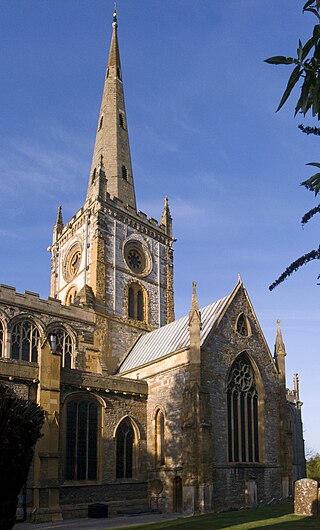
The Collegiate Church of the Holy and Undivided Trinity, Stratford-upon-Avon, is a Grade I listed parish church of the Church of England in Stratford-upon-Avon, Warwickshire, England. It is often known simply as Holy Trinity Church or as Shakespeare's Church, due to its fame as the place of baptism, marriage and burial of William Shakespeare. More than 200,000 tourists visit the church each year.
Kingston Bridge is a road bridge at Kingston upon Thames in south west London, England, carrying the A308 across the River Thames. It joins the town centre of Kingston in the Royal Borough of Kingston upon Thames to Hampton Court Park, Bushy Park, and the village of Hampton Wick in the London Borough of Richmond upon Thames. In 2005 it was carrying approximately 50,000 vehicles per day with up to 2,000 vehicles per hour in each direction during peak times.
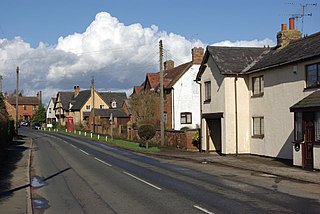
Bretford is a small hamlet in Warwickshire, England. It is part of the civil parish of Brandon and Bretford.

Atherstone on Stour is a small village and civil parish about 2+1⁄2 miles (4 km) south of Stratford-upon-Avon in Warwickshire, England. The 2011 Census recorded the parish's population as 59.
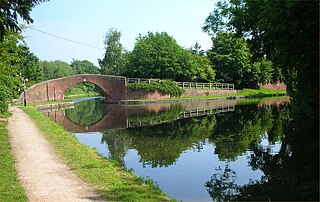
Kings Norton Junction is the name of the canal junction where the Stratford-upon-Avon Canal terminates and meets the Worcester and Birmingham Canal at Kings Norton, Birmingham, England.

Clopton House is a 17th-century country mansion near Stratford upon Avon, Warwickshire, now converted into residential apartments. It is a Grade II* listed building.

Honington, Warwickshire is a hamlet and civil parish in the Stratford-on-Avon District of Warwickshire, England. It is in the Brailes division of the hundred of Kington, and approximately two miles north of Shipston-on-Stour. The population taken at the 2011 census was 250. The River Stour flows past the village on the western side and has a 5-arched 17th-century bridge crossing it. Honington contains approximately 60 houses within the parish boundary, including the half-timbered Magpie Cottage, and Shoemaker's Cottage situated on the Green opposite the gates and lodge entrance to Honington Hall which was built in 1682 by Sir Henry Parker. The Church of All Saints has been re-built, but retains a 13th-century tower.

Chambers Crossing Halt railway station was a timber-framed railway halt on the Stratford-upon-Avon to Cheltenham section of the Honeybourne Line. The station was located two miles south-west of Stratford upon Avon. The site of the station is now part of the Stratford greenway and may in future form part of the Gloucestershire Warwickshire Railway's northern extension from Toddington.

Stratford's Historic Spine is the name given to a route in Stratford-upon-Avon along which many of the town's most important and historic buildings are sited, with many of the buildings connected to William Shakespeare. The Historic Spine was once the main route from the town centre to the parish church. It begins in Henley Street at Shakespeare's Birthplace and finishes in Old Town at The Holy Trinity Church and has buildings from the 14th up to the 20th centuries.
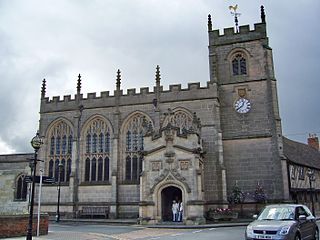
The Guild Chapel of the Holy Cross, Stratford-upon-Avon, Warwickshire is a chapel of 13th century origins. Founded by the Guild of the Holy Cross before 1269, it passed into the control of the town corporation in 1553, when the Guild was suppressed by Edward VI. The chapel stands on Church Street, opposite the site of William Shakespeare's home, New Place, and has historic connections to Shakespeare's family. The chapel was gifted an extensive series of wall-paintings by Hugh Clopton, an earlier owner of New Place, and John Shakespeare, Shakespeare's father, undertook their defacement in the later 1500s. The paintings have recently been conserved.

The Tramway Bridge is a grade II listed pedestrian bridge crossing the River Avon at Stratford-upon-Avon, Warwickshire, England.

Tidmington is a village and civil parish in the Stratford-on-Avon District of Warwickshire, England. It is 11 miles (18 km) south from the town of Stratford-upon-Avon, and at the extreme southern edge of the county bordering Gloucestershire. Within the parish is the Grade II* listed c.1600 Tidmington House, and the Grade II* early 13th-century church of unknown dedication. At the 2001 Census, which for statistical purposes now includes the neighbouring parish of Burmington, the combined population was 153.
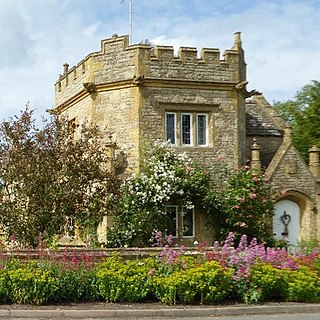
Little Wolford is a hamlet and civil parish in the Stratford-on-Avon district of Warwickshire, England. With the neighbouring parish of Great Wolford it is part of 'The Wolfords'. Little Wolford is significant for its Grade II* listed 15th- to 16th-century Little Wolford Manor.

Brandon Viaduct is a railway viaduct crossing the River Avon between the villages of Brandon and Wolston in Warwickshire. It carries the Birmingham Loop line and is roughly half way between Rugby and Coventry. The bridge was built in around 1835 for the London and Birmingham Railway and is now a grade II listed building.


















